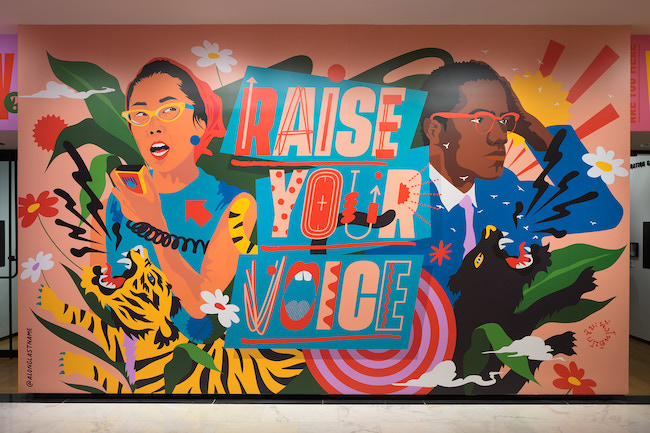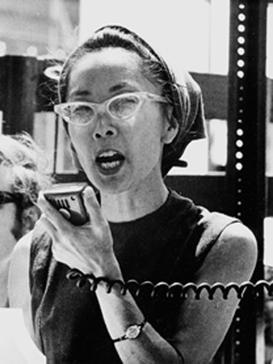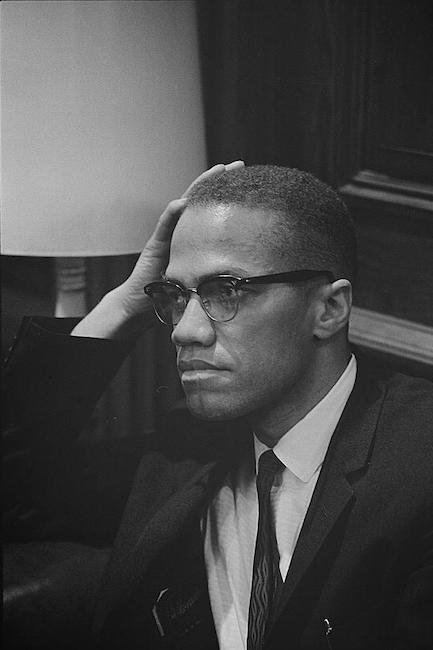Yuri Kochiyama and Malcolm X
Tuesday, February 22, 2022 by
Although no photograph exists of Yuri Kochiyama and Malcolm X alive together, their stories are deeply entwined. Kochiyama, a lifelong connector of people who worked mostly from her Harlem apartment, and Malcolm X, a heralded and much-criticized orator at religious and secular podiums, interacted in person and by mail over 16 months from 1963 to Malcolm X’s murder in 1965. They were both politized by prisons and were advocates for Black nationalism and against war—and they even shared a birthday, four years apart. Their juxtaposition in Amanda Phingbodhipakkiya’s installation Raise Your Voice at the Museum of the City of New York provides an opportunity to examine their brief but important connections, and their legacies for subsequent generations of activists in the Black and Asian American liberation movements and beyond.
Born far from New York, both Malcolm X and Yuri Kochiyama became identified with the city in the postwar era. Kochiyama (1921-2014) was born in Southern California to middle-class Japanese immigrant parents, while Malcolm X (1925-1965) was born in Nebraska to a mother from Grenada and a father from Georgia. During World War II the Kochiyama family was sent to a concentration camp in Arkansas, an event that catalyzed Kochiyama’s political awakening. Malcolm X had a different formative experience with incarceration: after avoiding the draft Malcolm X landed in prison in Massachusetts for larceny in 1946, where he became politicized and joined the National of Islam (NOI). Their paths led them both to New York: after his release and rise through NOI’s ranks, Malcolm X led Harlem’s Temple Number 7 beginning in 1954, whereas after the war Kochiyama joined her New Yorker husband Bill Kochiyama in the city–first residing in midtown and then moving to Harlem in 1960–where they became involved in the neighborhood’s Black-led freedom movement.
Kochiyama and Malcolm X crossed paths amidst this movement. They met in October 1963 during a campaign by the Congress of Racial Equality (CORE) to protest discriminatory hiring in construction jobs for the Downstate Medical Center in Brooklyn. Kochiyama and her son Eddie were arrested, along with hundreds of other protesters, for blocking truck traffic at the construction site, and she encountered Malcolm X at a subsequent courthouse proceeding in Brooklyn. After introducing herself, Kochiyama expressed ambivalence about Malcolm X’s critiques of integration. Malcolm X suggested they continue their conversation, and Kochiyama began writing him letters. When Malcolm X traveled throughout Africa in the summer of 1964, he, in turn, sent several postcards to the Kochiyama family.
Their next meeting illustrates their mutual opposition to war and nuclear weapons. In 1964 the Kochiyamas hosted atomic bomb survivors (hibakusha) who, as part of the Hiroshima-Nagasaki World Peace Mission Study, were on a walking tour of the United States, Europe, and the Soviet Union to push for nuclear disarmament. Kochiyama had invited Malcolm X to a reception at her apartment at their request, and when he arrived, he spoke about nuclear bombs and the bombs of racism. Malcolm X and Kochiyama also both engaged in activism against the Vietnam War, connecting US intervention in a non-white country with racism at home.
Finally, both activists lived lives of continual learning. A theme in books about Malcolm X and his own writings is the impact of reading and learning on his evolving views of Black liberation. Kochiyama, who characterized her own exposure to racial consciousness growing up as minimal, attended both the Freedom School and Malcolm X’s Organization of Afro-American Unity school in Harlem. She also attended Malcolm X’s speech at the Audubon Ballroom on February 21, 1965, where he was killed. While Kochiyama is often described as the person who held Malcolm X’s head as he lay dying, their connection predated and outlasted this pivotal day. Up until her death in 2014, Kochiyama continued her activism on political prisoners, internment reparations, and other issues – all while citing Malcolm X as her biggest influence.
Additional Reading:
Clarke, John Henrik, ed. Malcolm X: The Man and His Times. Africa World Press: Trenton, New Jersey, 1990.
Fujino, Diane C. Heartbeat of Struggle: The Revolutionary Life of Yuri Kochiyama. University of Minnesota Press, 2005.
Kochiyama, Yuri. Passing It On—A Memoir. University of California at Los Angeles Asian American Studies Center Press, 2004.
Marable, Manning. Malcolm X: A Life of Reinvention. Viking: New York, 2011.
Raise Your Voice is now on view.




